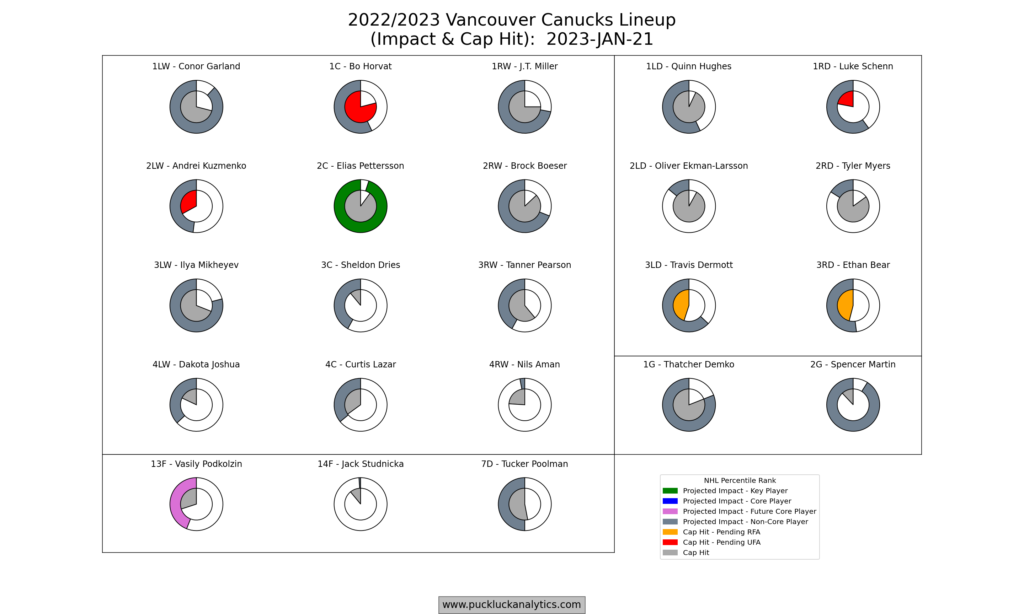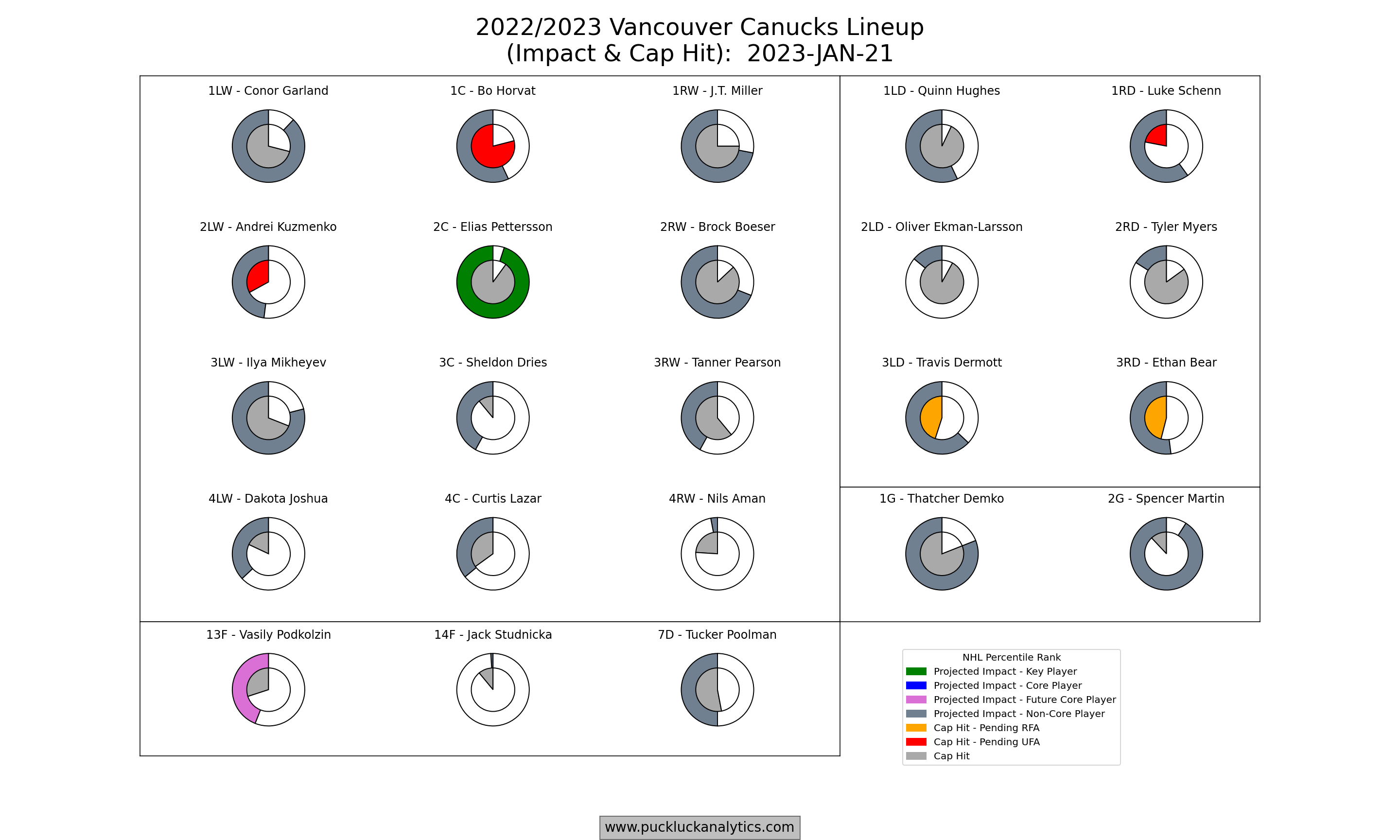If you’ve been following the blog this week, we’ve been walking through a teambuilding framework I’ve termed Roster Regeneration. The intent is to set up a team for long term success through multiple core groups without the need for a lengthy rebuild in between. I first laid out the framework, then we looked at the Vancouver Canucks roster to see how their current roster aligns with the framework. Now it’s time for the heavy lifting; putting together a strategy to bring the Canucks roster inline with the Roster Regeneration framework.
If you missed the previous two posts, I highly recommend giving them a read before continuing for important context:
Roster Regeneration: A Sustainable Teambuilding Strategy
Roster Review: Vancouver Canucks – January 21, 2023
Current Roster Regeneration Status
To recap where we left off last time, let’s take another look at where the Canucks roster sits today:
| Category | Have | Need |
| Key Players | C – Elias Petterson | 1 Elite Forward 1 Elite Defenseman |
| Contention Core | RW – Brock Boeser RW/LW – Conor Garland LW/RW – Ilya Mikheyev | 1-2 Centers 1 Wingers 2 Defensemen |
| Future Core | LW/RW – Nils Hoglander LW/RW – Vasily Podkolzin | F, D Prospects with star potential F, D, G Prospects with NHLer potential |
We have one Key Player (Elias Pettersson) that we think we can build around for the next decade or longer. The current contention core is sub-par, as is the future core. In short, we’re nowhere close to where we want to be since we’re not good enough to contend now and the upcoming core is not likely to be good enough to contend when the current core starts to decline.
Roster Roadmap
In order to bring the Canucks roster inline with the Roster Regeneration framework, we really only have one general path in front of us. We can’t build up the current core because, even if we could make it a contender before it declines, we would necessarily deplete the future core even further in the process. That would force us into a lengthy rebuild since the future core wouldn’t be ready to take over and we wouldn’t have a roster ready to follow the Roster Regeneration framework.
To move the roster toward the Roster Regeneration framework, we need to focus on building the future core such that it’s ready to contend when the players in that cohort reach their prime. Nils Hoglander and Vasily Podkolzin give us a starting point and we want to add players of similar age and slightly younger. Ideally, we’ll target players in the 18-20 range but under 22 is acceptable.
With our target being players age 22 or younger and a current contention core that isn’t good enough to contend, we’ll make every player age 23 or older expendable. The lone exception is Elias Pettersson, who is still likely to be a quality top line center when our current core hits their prime.
2023 Trade Deadline
The 2023 trade deadline is the first major milestone where we have an opportunity to start making meaningful moves toward our objectives. We should consider moving every player we’ve made available if the right offer comes our way but our focus should be on moving our pending free agents that don’t fit in our plans for our future core.

Bo Horvat, Andrei Kuzmenko and Luke Schenn are pending UFAs and will be past their prime years by the time our future core hits their stride. Travis Dermott and Ethan Bear are pending RFAs but are also a few years older than our future core. We should seriously consider moving them as well since their age and RFA status may bump their trade value up and they aren’t in our long term plans. If there isn’t a suitable deal though, it’s reasonable to re-sign them to fill out our roster next season. If we take that route, we want to avoid longer term contracts that will clog up our roster when the future core starts taking over the NHL lineup.
The primary pieces we’re looking for in the return on any of these trades are prospects in the 18-20 age range, preferably with high star potential since we want them to grow into top six forward or top three defense roles. A look at the Hockey Prospecting model alongside some historical trades gives us a sense of what might be possible.
Last season, the New York Rangers acquired Andrew Copp and a 6th round pick in exchange for Morgan Barron, a 1st round pick, a 2nd round pick and a 5th round pick. Horvat is a higher impact player than Copp, so a trade package that includes a 1st round pick + doesn’t seem out of the question. However, we’re more interested in already drafted prospects than draft picks given the target age range we have for our future core. So instead of a 1st round pick, we’d prefer to build a trade package around a high level prospect.
For example, the New Jersey Devils are one of the teams rumored to be interested in Horvat and they also have a prospect pool loaded with high end defense prospects. At the top are Luke Hughes (age 19, star probability 90%) and Simon Nemec (age 18, star probability 78%) who fit our needs exactly. In fact, they are such a good fit that it would be reasonable to attach a later round draft pick to Horvat to make the deal work if needed. We aren’t going to re-sign Horvat anyway. If we can land a prospect like this, there’s also a reasonable chance that they can become a Key Player for us rather than simply a member of the future core.
If we follow a similar strategy with our other pending UFAs and potentially our pending RFAs, we’ll add 3-5 good to great prospects to our prospect pool before the 2023/24 season is out.
2023 Offseason and Beyond
With a depleted roster following our 2023 trade deadline moves, we’ll have two objectives in the 2023 offseason. First, continue to acquire prospects that fit our future core age window, preferably with high star potential. This will necessarily be done almost entirely through trades, given the age and quality of the prospects we’re looking for.
Second, we’ll acquire NHL players that can fill out the top half of our NHL roster while we get the rest of our house in order. We don’t care if they’re elite. Competent will be sufficient. They need to buy us time for the future core to develop while avoiding letting a losing culture set in.
We’ll continue to follow a similar strategy until we’re confident that we have a sufficient number of prospects to build a core of 5-6 forwards, 3-4 defensemen and a starting goaltender that will begin to hit their stride around the 2026/27 season. At that time, Pettersson will be 28, Hoglander 26 and Podkolzin 25 and the majority of our core will be age 23-26. Only 3 players on the current NHL roster will still be on their current contracts at that time (J.T. Miller, Oliver Ekman-Larsson, and Quinn Hughes), so we’ll have an opportunity to move on from nearly every player on the current roster if we so choose.
As the future core nears their prime, we’ll also start focusing more on consolidating draft picks in a 2-3 year stretch roughly 5-7 years behind the front of the future core. That will set us up to start building the next contention cohort that can help us hold onto contention status as the Hoglander/Podkolzin core starts to pass their prime.
Interested in digging deeper into the Canucks’ roster or investigating your favorite team? Sign up for an annual membership to get access to all 22/23 team and player projection plots. Plots are updated to track progress through the season so you can follow along with the changing landscape.
Historical player data from Natural Stat Trick. Contract data from CapFriendly.




